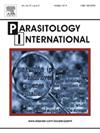Role of the cymothoid isopod, Nerocila bivittata in spread of Photobacterium damselae subsp piscicida to Thinlip mullet (Chelon ramada)
IF 1.5
4区 医学
Q3 PARASITOLOGY
引用次数: 0
Abstract
Cymothoid isopods are among the most devastating parasitic crustaceans in mariculture worldwide. A private marine fish farm in Ismailia province, Egypt suffered mass mortalities in cultured Chelon ramada during the late summer of 2022. The present study aims to reveal the role of the isopod, Nerocila bivittate (N. bivitata) in spread of the evolving prolonged spread of the devastating bacterial disease, Photobacterium damselae subsp piscicida (P. dmselae subsp piscicida) to Chelon ramada. This study was carried out on one hundred and fifty C. ramada collected during different phases of mortalities. Moribund fish showed signs of respiratory distress, erratic movements and poor appetite. Infested fish gills were pale anemic with excessive mucus secretion. Nerocila bivittata was isolated from the gill chamber, buccal cavity, caudal, and dorsal fins of infested fish. The infestation percentage was 26.5 % where gills of infested fish were the most affected tissue. The bipolar bodies of the P. damselae subsp piscicida were remarkably detected within the isopod hemolymph using transmission electron microscope. Further, P. damselae subsp piscida was isolated from both N. bivitata. Both P. damelae subsp piscida and N. bivitata were molecularly confirmed utilizing the 16S ribosomal RNA. In conclusion, N. bivittata infestation is responsible for high economic losses due to fish mortalities, reduced growth rates and increased susceptibility to devastating prolonged bacterial infections.
棘足类等足类褐藻(Nerocila bivittata)在少女光杆菌(damselae subsp piscicida)向细唇鲻鱼(Chelon umada)传播中的作用
卵状等足类动物是全球海水养殖中最具破坏性的寄生甲壳类动物。2022年夏末,埃及伊斯梅利亚省的一家私人海洋养鱼场养殖的切龙(Chelon ramada)大量死亡。本研究的目的是揭示等足类动物,双叶蝉(N. bivitata)在破坏性细菌性疾病,光细菌damselae subsp piscicida (P. dmselae subsp piscicida)在螯龙(Chelon ramada)上的传播过程中的作用。本研究是在不同的死亡阶段收集的150只C. ramada进行的。濒死的鱼表现出呼吸困难、动作不稳定和食欲不振的迹象。受感染的鱼鳃苍白贫血,粘液分泌过多。从感染鱼的鳃腔、颊腔、尾鳍和背鳍中分离出双鳃线虫。侵染率为26.5%,以鱼鳃为主要侵染部位。用透射电镜在等足类血淋巴中观察到豆selae subsp piscicida的双极体。此外,从两种植物中都分离到了豆selae pspsppiscida。利用16S核糖体RNA进行分子鉴定。综上所述,双歧螺旋体侵染造成了巨大的经济损失,原因是鱼类死亡、生长速度下降和对破坏性长期细菌感染的易感性增加。
本文章由计算机程序翻译,如有差异,请以英文原文为准。
求助全文
约1分钟内获得全文
求助全文
来源期刊

Parasitology International
医学-寄生虫学
CiteScore
4.00
自引率
10.50%
发文量
140
审稿时长
61 days
期刊介绍:
Parasitology International provides a medium for rapid, carefully reviewed publications in the field of human and animal parasitology. Original papers, rapid communications, and original case reports from all geographical areas and covering all parasitological disciplines, including structure, immunology, cell biology, biochemistry, molecular biology, and systematics, may be submitted. Reviews on recent developments are invited regularly, but suggestions in this respect are welcome. Letters to the Editor commenting on any aspect of the Journal are also welcome.
 求助内容:
求助内容: 应助结果提醒方式:
应助结果提醒方式:


